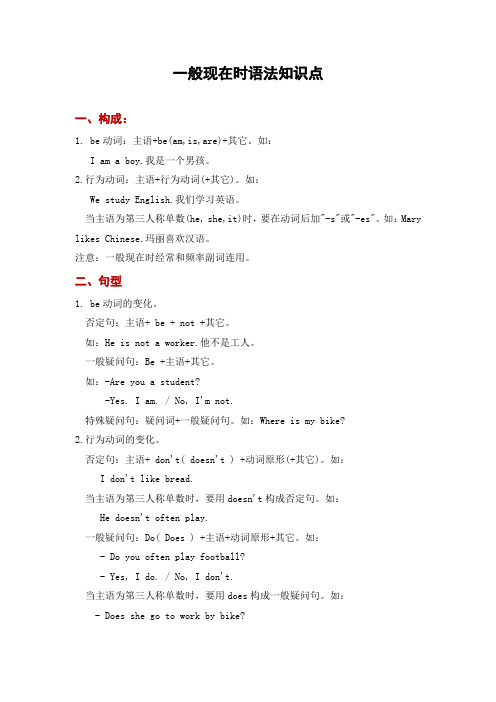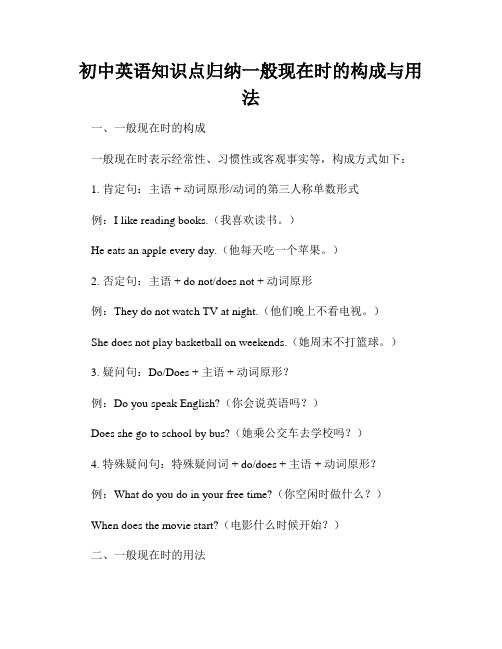七年级下册英语语法《一般现在时》知识点整理
完整版)一般现在时的语法总结

完整版)一般现在时的语法总结一般现在时是用来表示通常性、规律性、惯性状态或动作的时间状态。
当主语为第三人称单数时,肯定句的结构为主语+动词的第三人称单数+其他,否定句为主语+doesn't+动词原形+其他,一般疑问句为Does+主语+动词原形+其他,肯定回答为Yes,主语+does,否定回答为No,主语+doesn't。
特殊疑问句为特殊疑问词+一般疑问句。
当主语不是第三人称单数时,肯定句的结构为主语+动词原形+其他,否定句为主语+don't+动词原形+其他,一般疑问句为Do+主语+动词原形+其他,肯定回答为Yes,主语+do,否定回答为No,主语+don't。
需要注意的是,句式结构错则全局都错。
变化规律包括清辅音后读/s/,一般情况加-s,浊辅音和元音后读/z/,以o结尾的词、以s、sh、ch、x等结尾的词、以辅音字母+y结尾的词加-es读/z/,变y为i再加es,变have为has,变be为am、is、are读/z/。
一般现在时可以用来表示经常的或惯性的动作,常与表示频率的时间状语连用,如always、usually、regularly、XXX、often、sometimes、nally、from time to time、twice a week、rarely、seldom、once a month、hardly、ever、never。
也可以用来表示主语具备的性格、能力、特征和状态。
3.用一般现在时来表达客观事实和普遍真理,例如:地球绕着太阳转,上海位于中国的东部。
4.在时间状语从句和条件状语从句中,常用一般现在时代替将来时。
5.一般现在时用于表示预先计划或安排好的行为。
6.在小说故事中,一般现在时常代替一般过去时。
而在新闻报道等内容中,为了体现其“新鲜”性,也常用一般现在时来描述过去发生的事情。
7.有些表示状态和感觉的动词在描述现在发生的具体行为时,只用一般现在时,而不用进行时态。
一般现在时所有知识点

一般现在时知识点一般现在时是英语语法中的重要时态之一,它表示通常、经常或习惯性的动作或状态,是英语中最基本的时态之一。
下面是一般现在时的知识点总结和重难点精析。
一、知识点总结1、一般现在时的定义和适用范围一般现在时主要用来描述通常发生的动作、习惯或状态,例如:I usually get up at 7 o’clock. (我通常在7点起床。
)它也可以用来描述永恒不变的事实或真理,例如:The sun rises in the east. (太阳从东方升起。
)2、一般现在时的动词形式和词义一般现在时的动词形式包括原形动词、第三人称单数形式的动词(通常在动词词尾加-s或-es)和第一人称、第二人称及复数形式的动词(通常在动词词尾加-we和-you)。
具体形式如下:I/we/they/you + 动词原形he/she/it + 动词的第三人称单数形式例如:I walk to school. (我步行去学校。
)He plays tennis every Sunday. (他每个星期天都打网球。
)3、一般现在时的时间表达方式一般现在时的时间表达方式通常是通过时间状语来表示,例如:always(总是),usually(通常),often(经常),never(从不),sometimes(有时)等。
4、一般现在时的修辞手法修辞手法主要是通过语言表达方式来强调某种语气或情感,例如:使用情态动词can、may、must等来表达某种可能性或必要性,或者使用程度副词如completely(完全地)、absolutely(绝对地)等来强调某种程度。
二、重难点精析1、一般现在时与现在进行时的区别现在进行时表示正在进行的动作或状态,而一般现在时表示通常或习惯性的动作或状态。
例如:I am studying now. (我现在正在学习。
)I usually study in the evening. (我通常在晚上学习。
)2、一般现在时与将来完成时的联系将来完成时表示将来某个时间已经完成的动作或状态,而一般现在时表示现在或习惯性的动作或状态。
一般现在时七年级知识点

一般现在时七年级知识点一般现在时是英语语法中最基础的一个时态,也是最常用的一个时态。
它表示的是现在正在进行的动作或者现在的状况。
在七年级阶段,我们需要学会如何正确地使用一般现在时。
本文将重点介绍一些在七年级需要掌握的一般现在时的知识点。
一、动词原形在一般现在时中,我们需要使用动词原形(也叫基本形式)作为谓语动词。
例如:I play basketball every day.She reads books in her free time.注意:第三人称单数形式的动词要加上“-s”或“-es”。
例如:He reads books in his free time.She plays the piano every day.二、第三人称单数形式第三人称单数形式指的是以“-s”或“-es”结尾的动词形式,是在句子中表示第三人称单数主语时使用的动词形式。
例如:He likes to play soccer.She teaches English at the school.注意:有些动词的第三人称单数形式并不是以“-s”或“-es”结尾,例如“have”、“do”等。
这些动词在第三人称单数时不需要变化。
三、句型在一般现在时中,我们需要掌握以下两种基本的句型。
1. 主语+动词原形例如:I play basketball every day.They sing songs in the classroom.2. 主语+助动词“do/does”+动词原形例如:Do you like to eat pizza?Does she go to school by bus?注意:在第三人称单数形式的句子中,需要使用助动词“does”,例如:Does he like to play soccer?Does she play the piano every day?四、时间状语在一般现在时中,我们通常会加上时间状语来表明动作发生的时间或者频率。
一般现在时语法知识点

一般现在时语法知识点一、构成:1. be动词:主语+be(am,is,are)+其它。
如:I am a boy.我是一个男孩。
2.行为动词:主语+行为动词(+其它)。
如:We study English.我们学习英语。
当主语为第三人称单数(he, she,it)时,要在动词后加"-s"或"-es"。
如:Mary likes Chinese.玛丽喜欢汉语。
注意:一般现在时经常和频率副词连用。
二、句型1. be动词的变化。
否定句:主语+ be + not +其它。
如:He is not a worker.他不是工人。
一般疑问句:Be +主语+其它。
如:-Are you a student?-Yes. I am. / No, I'm not.特殊疑问句:疑问词+一般疑问句。
如:Where is my bike?2.行为动词的变化。
否定句:主语+ don't( doesn't ) +动词原形(+其它)。
如:I don't like bread.当主语为第三人称单数时,要用doesn't构成否定句。
如:He doesn't often play.一般疑问句:Do( Does ) +主语+动词原形+其它。
如:- Do you often play football?- Yes, I do. / No, I don't.当主语为第三人称单数时,要用does构成一般疑问句。
如:- Does she go to work by bike?- Yes, she does. / No, she doesn't.特殊疑问句:疑问词+一般疑问句。
如:How does your father go to work? 动词第三人称单数形式构成规则动词原形变第三人称单数的规则与发音规律同名词单数变复数大致相同,请认真观察。
1、大多数动词在词尾加“S”在清辅音后发音为[s],在浊辅音及元音后发音为[z]。
一般现在时的知识点归纳七年级

一般现在时的知识点归纳七年级七年级英语教学中,一般现在时是最重要的语法点之一。
通过良好的教学方法和个性化的教学方式,学生们可以轻松掌握这一知识点。
在本文中,我们将对一般现在时进行深入剖析,来帮助学生更好地掌握这一知识点。
一、一般现在时的定义一般现在时指的是现在正在发生或经常发生的动作或状态。
它的时态形式为:主语(第三人称单数要加s或es) + 动词原形。
例如:He plays basketball.(他打篮球。
)二、一般现在时的用法1. 表述客观事实:比如地理事实、自然现象、名人事实等。
例如:The sun rises in the east.(太阳从东方升起。
)2.表述经常性动作或状态:比如习惯性的动作、日常行为、反复发生的动作等。
例如:I usually go to bed at 10 p.m.(我通常在晚上10点钟睡觉。
)3.表述真理或普遍事实:比如科学定理、社会现象、人定律等。
例如:Water freezes at 0 degrees Celsius.(水在零度时结冰。
)4. 表示主语所具备的特征等性质。
例如:She is kind and friendly.(她友善又和蔼。
)三、一般现在时的标志词一般现在时没有专门的标志词,但在使用中,我们通常可以根据上下文来判断。
四、一般现在时的否定句和疑问句1.否定句:在be动词后加not,其他动词在前面加助动词do/does,其后紧随not。
例如:He does not run fast.(他跑得不快。
)2. 疑问句:将助动词do/does提前到主语前,其他句子成分不变。
例如: Do you like playing basketball?(你喜欢打篮球吗?)五、常见的时间状语时间状语指的是句子中表示时间的词或短语。
以下是常见的时间状语:1. every day (每天)2. every week (每周)3. every month (每月)4. every year (每年)5. on Monday (在星期一)6. in the morning (在早晨)7. at night (在晚上)8. at the weekend (在周末)六、一般现在时常见错误1. 第三人称单数动词形式错误:在第三人称单数主语后要加s/es。
一般现在时知识点总结

一般现在时知识点总结1.句子结构:一般现在时的句子结构一般包括主语+动词+其他成分。
-主语:表示动作的执行者或状态的拥有者。
- 动词:一般现在时的动词形式常为原形动词,但第三人称单数形式需加-s或-es。
-其他成分:指出动作发生的时间、地点或方式等。
2. 第三人称单数形式:在一般现在时中,第三人称单数形式的动词需加-s或-es。
- 当主语为第三人称单数名词、代词或不定代词时,动词需加-s或-es。
例如:She walks to school every day.(她每天步行去学校。
)- 当主语以不发音的-s、-x、-sh、-ch或-o结尾时,动词需加-es。
例如:He watches TV every evening.(他每天晚上看电视。
)3.经常性动作:一般现在时通常用来表示经常性或习惯性的动作。
- 常与表示频率的短语连用,例如:every day(每天)、once a week(每周一次)、twice a month(每月两次)等。
4.准确性描述:一般现在时也用于描述客观真理、事实或普遍现象。
- 描述客观真理:例如:Water boils at 100 degrees Celsius.(水在100摄氏度时沸腾。
)- 描述事实:例如:The earth revolves around the sun.(地球绕着太阳旋转。
)- 描述普遍现象:例如:Cats eat fish.(猫吃鱼。
)5.目前状态:一般现在时也可用来描述目前的状态或存在。
- 描述目前状态:例如:She looks tired today.(她今天看起来很累。
- 描述存在:例如:There is a book on the table.(桌上有一本书。
)6.时间状语:一般现在时常与时间状语连用,以指出动作发生的时间。
- 表示经常性或习惯性的动作:例如:I always go to the park on Sundays.(我每个星期天都去公园。
一般现在时语法知识点总结

一般现在时语法知识点总结一、一般现在时的概念。
一般现在时表示经常的、习惯性的动作或存在的状态。
例如:I often get up at six o'clock.(我经常在六点钟起床。
)The earth goes around the sun.(地球绕着太阳转。
)二、一般现在时的构成。
1. be动词的一般现在时形式。
- 主语为第一人称单数(I)时,be动词用am。
例如:I am a student.- 主语为第三人称单数(he/she/it等)时,be动词用is。
例如:He is a doctor.- 主语为第二人称单数(you)、第一人称复数(we)、第二人称复数(you)、第三人称复数(they)时,be动词用are。
例如:You are my friends. They are workers.2. 实义动词(行为动词)的一般现在时形式。
- 当主语为第三人称单数(he/she/it,单个的人名、地名或单数可数名词等)时,实义动词一般在词尾加 -s或 -es。
- 一般情况下加 -s,如:play - plays,like - likes。
- 以s,x,ch,sh,o结尾的动词加 -es,如:go - goes,watch - watches。
- 以辅音字母 + y结尾的动词,把y变为i再加 -es,如:study - studies。
- 当主语为第一人称单数(I)、第二人称单数(you)、第一人称复数(we)、第二人称复数(you)、第三人称复数(they)时,实义动词用原形。
例如:I like reading. They play football every day.三、一般现在时的用法。
1. 表示经常或习惯性的动作。
- 常与表示频率的副词或短语连用,如:always(总是),usually(通常),often(经常),sometimes(有时),seldom(很少),never(从不),every day (每天),once a week(每周一次)等。
初中英语知识点归纳一般现在时的构成与用法

初中英语知识点归纳一般现在时的构成与用法一、一般现在时的构成一般现在时表示经常性、习惯性或客观事实等,构成方式如下:1. 肯定句:主语 + 动词原形/动词的第三人称单数形式例:I like reading books.(我喜欢读书。
)He eats an apple every day.(他每天吃一个苹果。
)2. 否定句:主语 + do not/does not + 动词原形例:They do not watch TV at night.(他们晚上不看电视。
)She does not play basketball on weekends.(她周末不打篮球。
)3. 疑问句:Do/Does + 主语 + 动词原形?例:Do you speak English?(你会说英语吗?)Does she go to school by bus?(她乘公交车去学校吗?)4. 特殊疑问句:特殊疑问词 + do/does + 主语 + 动词原形?例:What do you do in your free time?(你空闲时做什么?)When does the movie start?(电影什么时候开始?)二、一般现在时的用法一般现在时用于以下几种情况:1. 表示经常性或习惯性的动作或状态。
例:My mother often cooks dinner for us.(我妈妈经常给我们做晚饭。
)We usually go to the park on weekends.(我们通常在周末去公园。
)2. 表示客观事实、自然规律或科学真理。
例:The sun rises in the east.(太阳从东方升起。
)Water boils at 100 degrees Celsius.(水在100摄氏度沸腾。
)3. 表示现有状况或个人特征。
例:I have two cats.(我有两只猫。
)She lives in London.(她住在伦敦。
- 1、下载文档前请自行甄别文档内容的完整性,平台不提供额外的编辑、内容补充、找答案等附加服务。
- 2、"仅部分预览"的文档,不可在线预览部分如存在完整性等问题,可反馈申请退款(可完整预览的文档不适用该条件!)。
- 3、如文档侵犯您的权益,请联系客服反馈,我们会尽快为您处理(人工客服工作时间:9:00-18:30)。
一般现在时
一、一般现在时定义:
①经常性、习惯性的动作或存在的状态。
e.g. I go to school on foot.
e.g.:He is very busy now.
e.g.:She is ten.(她十岁了。
)
e.g.:Kate is in the classroom. (凯特在教室里。
)
e.g.: We often call to each other.(我们时常相互通信)。
③表示主语现在的性格、特征、能力。
e.g. He can swim.
e.g.:I work hard.
e.g.:I like watching TV.
e.g.:I like English. We can speak English.
④表示客观真理。
e.g. There are seven days in a week.
e.g.:The moon moves round the earth.
e.g.:The sun is bigger than the moon. (太阳比月亮大。
)
二、一般现在时的构成:
1、当谓语动词是be 动词am, is ,are时,
1)肯定句式主语+ am/ are/ is +其他。
2)否定句式主语+ am/ are/ is + not +其他。
3)一般疑问句
Am/ Is/ Are +主语+其他?
肯定回答 Yes, 主语(必须是代词)+ am/ is/ are
否定回答 No, 主语(必须是代词)+ am/ is/ are + not(必须用缩写形式 isn't/aren't)
e.g.:Danny is a good student.
Danny isn’t a good student.
Is Danny a good student?
Yes, she is.
No,she isn’t.
2、当谓语动词是行为动词(实义动词)时
1)当主语是第一人称 (I / we) ; 第二人称 (you) 及第三人称复数(they及复数的名词)时:
①肯定句主语+行为动词原形+其他
②否定句主语+don’t +行为动词原形+其他
③一般疑问句Do +主语+行为动词原形+其他
肯定回答 Yes, 主语(必须是代词)+do
否定回答 No, 主语(必须是代词)+don’t
e.g.:They have lunch at 12:00.
They don’t have lunch at 12:00.
Do they have lunch at 12:00?
Yes, they do.
No, they don’t.
2)当主语是第三人称单数 (she/ he/ it及单数的名词) 时
①肯定句主语+行为动词的单三形式+其他
②否定句主语+doesn’t +行为动词原形+其他
③一般疑问句Does +主语+行为动词原形+其他
肯定回答 Yes, 主语(必须是代词)+ does
否定回答 No, 主语(必须是代词)+doesn’t
e.g.:Jenny speaks English very well.
Jenny doesn’t speak English very well.
Does Jenny speak English very well?
Yes, she does.
No, she doesn’t.
3.当谓语动词是情态动词+行为动词时:
1)肯定句主语+(情态动词 +行为动词原形)+其他
2)否定句主语+(情态动词 +not+行为动词原形)+其他
3)一般疑问句情态动词+主语+行为动词原形+其他?
肯定回答 Yes, 主语(必须是代词)+情态动词
否定回答 No, 主语(必须是代词)+情态动词 +not(必须是缩写形式can’t, mustn’t, shouldn’t, needn’t等)
e.g.:Tom can speak Chinese. 汤姆会说汉语。
Tom can’t speak Chine se. 汤姆不会说汉语。
Can Tom speak Chinese? 汤姆会说汉语吗?
Yes, he can.
No, he can’t.
三.动词第三人称单数词尾变化有三种形式:
(1)一般动词在词尾加-s,-s在清辅音后读/s/,在浊辅音或元音后读/z /,ds读/dz/,ts读/ts/。
如:
help→helps,know→knows,get→gets,read→reads
(2)以字母s,x,ch,sh或有些以o结尾的动词加-es,-es读/iz/。
如:
guess→guesses,fix→fixes,teach→teaches,wash→washes
注意:go→goes do→does
(3)以辅音字母+y结尾的动词,先变y为i,再加-es,-ies读/iz/。
如:
carry→carries,fly→flies
注:在play→plays/pleiz/,say→says/sez/中,字母y前为元音字母,第三人称单数形式直接在动词后面加-s。
(4)特殊词例外。
如:be→is,have→has
四、对do的理解
例:We don’t (not do) our homework in the afternoon.
答案:don’t do
解析:do是一个比较难理解的词,它有三个含义: a)是所有行为动词的总称;b)是助动词,无实义;c)是一个具体的行为动词“做,干”。
此句中给出的do指“做,干”,not指把此句变为否定句,故须在do前加助动词don’t。
本文由索罗学院整理。
